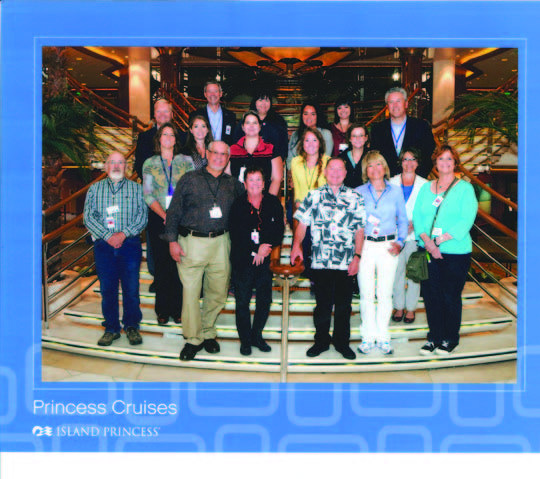Cruising green in Alaska
By Kim Kovol, Executive Director, and
Anne Stefanich, Technical Assistance Coordinator, Green Star
Quick, name 29 communities in Alaska that have an average population of 2,300 people, recycle 60 percent of their waste, and contribute approximately $1 billion to the economy. Give up? Welcome to Alaska’s cruise industry.
“More than one million cruise passengers will visit the state this year. Approximately 350,000 will cross the Gulf of Alaska, either departing or arriving in Anchorage through the ports of Seward or Whittier,” according to Cruise Lines International Association Alaska (CLIA Alaska).
In July, Green Star staff went on a behind the scenes tour of the Island Princess to see the inner workings of the cruise industry and its ships.
The first notable aspect of the Island Princess was its spotlessness. There is none of the litter, dirt, or other waste materials commonly found on the average sidewalk. Crews clean with environmentally friendly products that do not include bleach or pine-scented antibacterial agents. These floating communities travel through some of the most pristine waters in the Pacific Northwest, so reducing the risk of any contamination of the waterways is a priority.
An average person on a cruise generates about nine pounds of solid waste per day. On a typical seven-day Alaskan Inside Passage cruise, that equates to 63 pounds per person or more than 70 tons per ship on average. So keeping this floating city clean and waste-free is no small undertaking.
The Island Princess has an on-board recycling program that rivals some of the best community programs in the country. About six tons of glass is crushed and off-loaded to onshore recyclers every two weeks. Also recycled on the ship is aluminum, steel, cardboard, paper, plastic, and textiles.
The Island Princess also operates extensive black and grey-water reclamation systems. Each guest generates about 60 gallons of liquid waste per day on a cruise. Black water (sewage) and grey water (shower and sink discharge) are put through a multiple-step cleaning system that includes a bacterial bioreactor and UV sanitation. The end product is purified to drinkable standards (and Green Star staff did drink it!) before it ever leaves the ship. Bilge water (water and other fluids that collect in the lowest part of the ship) is also collected and properly processed by a different system. The oil content of the bilge water effluent (without dilution) is 15 parts per million.
The Island Princess has two diesel and one gas turbines on board. The system is big enough to power 11,000 homes, about the size of the Palmer- Wasilla area. To reduce air emissions, the ship powers down to one generator in ports such as Whittier, Ketchikan, Sitka, and Skagway. When it arrives in Juneau, it can shut down completely with the help of a new “plug in” system. This system was piloted in Juneau in 2001 and has since been installed in other ports, such as Vancouver, Los Angeles, San Diego, San Francisco, and Seattle.
To comply with strict U.S. Environmental Protection Agency regulations and even stricter state and company regulations, each of the ships in the Princess fleet has a full-time Environmental Officer who is responsible for keeping all systems running cleanly and in compliance with the regulations of the jurisdictions in which the ship is currently sailing.
With so much of Anchorage’s economy relying on tourism and travel, the environmental and economic sustainability of each cruise ship increases the sustainability of Anchorage’s business community as a whole. So the next time you see one of these great ships in port, remember that it is striving to set an environmental standard all communities can emulate while also helping to support the state’s economy.

In July, Green Star and RDC staff, as well as other Alaskans, went on a behind the scenes tour of the Island Princess to see the inner workings of the cruise industry and its ships.
(Photo courtesy of Princess Cruises)

Editor’s Note: This is a shortened version of a
story originally run in Green Star’s E-News communication.
Return to newsletter headlines